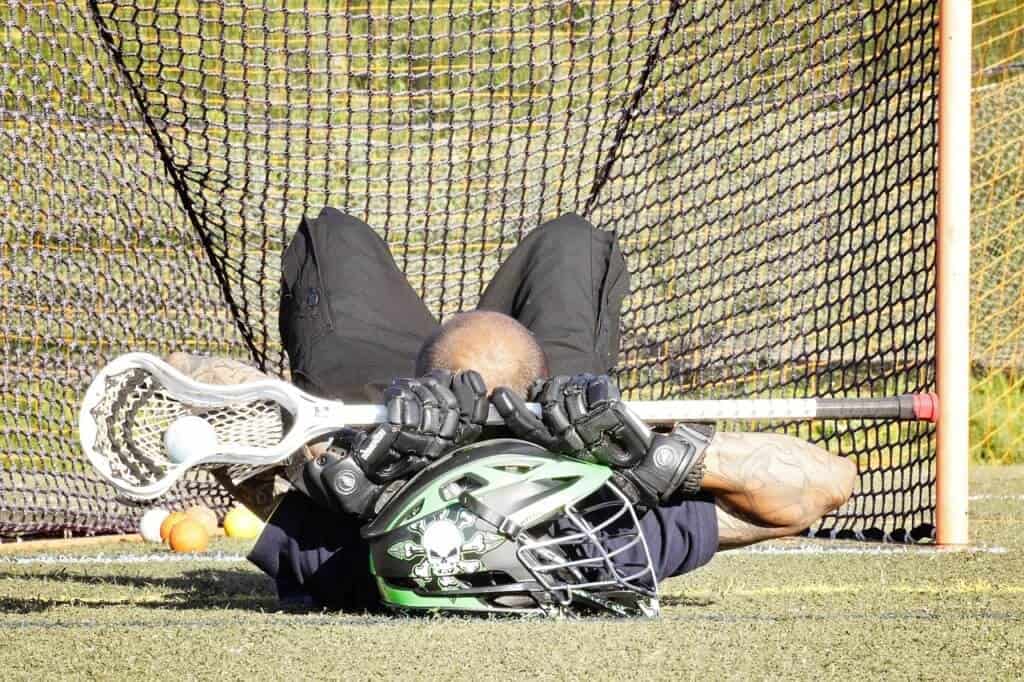There are so many great ways to stay active and fit. Kids and adults both benefit from participating in sports activities. One of the fastest growing team sports in the United States is Lacrosse. In this article, we will take a look at the fascinating history of Lacrosse, explore elements of the sport, and discuss safety and Lacrosse.
What is Lacrosse?
Lacrosse is a high-energy team sport, played with a lacrosse ball and a stick, which is the “crosse”. The head of the lacrosse stick is used by players to move the ball around. Moving the ball includes passing, carrying, catching and shooting the ball into the goal.
Four Types of Lacrosse
There are four ways to play lacrosse, each with its own set of rules and equipment. The four versions of lacrosse are:
While all of these versions of lacrosse include the use of the lacrosse stick and lacrosse ball, there are some significant differences as well.
Field Lacrosse
Field lacrosse is an outdoor game played by a team of 10 men. The first set of rules for this game were outlined in 1867.
The object of field lacrosse is to use the lacrosse stick, the crosse, to score by catching, carrying, passing and ultimately shooting the lacrosse ball into the other team’s goal. Opposing teams work to keep each other from scoring, and this includes a lot of body contact.
The lacrosse stick holds and passes the ball by way of a loose net, located on the triangular head of the stick. The lacrosse ball is solid rubber, usually white, and about 8” in diameter.
Players of field lacrosse wear a good bit of protective equipment, as protection from the body contact and stick-to-body contact.
Here is a basic list of field lacrosse rules
Women’s/Girl’s Lacrosse
Women’s lacrosse is played with 12 players, and the rules differ a bit from field (men’s) lacrosse.
However, the method of scoring is the same. Players use the lacrosse stick to move the ball around the field, attempting to shoot the lacrosse ball into the opposing team’s goal.
Women’s lacrosse is a non-contact sport, and players use body position and stick positioning to block opposing team players.
Because there is no body contact, protective gear is minimal. Women wear a mouth guard and protective eyewear.
Here is a basic list of women’s lacrosse rules
Box Lacrosse
Box lacrosse is played indoors, usually on an ice hockey rink after the ice has been removed.
Teams consist of 5 players and one goalie. The playing area is referred to as a “box”, as opposed to the open field of field lacrosse.
Other than that, box lacrosse and field lacrosse are quite similar and include collision-style body contact.
Box lacrosse has traditionally been a man’s sport, but women’s box lacrosse teams have recently been formed.
Intercrosse
Intercrosse is also called
- Soft stick lacrosse
- Softcrosse
- Modcrosse
- Popcrosse
Intercrosse is a form of non-contact lacrosse that uses modified equipment, including the stick and ball. The intercrosse stick is softer and made of plastic, and the intercrosse ball is larger. The ball is hollow inside as well, making it softer.
Intercrosse is non-gender specific and is a great way to introduce children to the sport.
Here is a basic list of intercrosse rules

History of Lacrosse
Lacrosse is just one of the field sport games originally played by Native Americans. These games were recreational but also had more serious roles as well. Lacrosse and other stick-and-ball games were played for:
- Settling dispute between tribes
- Venting aggression between tribes or individuals
- Deciding territorial disputes
- Honoring the Creator
The game of women’s field lacrosse remains the style of lacrosse most similar to the Native American original version.
The Eastern Native American tribes used a stick that is most similar to modern-day lacrosse sticks, and balls were generally made from animal hide filled with hair.
The game was steeped in Native American spirituality, and players were considered warriors who cleansed and purified themselves prior to matches. Shamans assisted with training these warriors, offering incantations and other ceremonies to increase the potential for victory.
More on the history of lacrosse:
- History | US Lacrosse
- The History Of Lacrosse. Who Invented Lacrosse?
- The True History Of Lacrosse – Odyssey
Benefits of Playing Lacrosse
Why play lacrosse as opposed to the many team sports available today? Let’s take a look
10 Reasons to Play Lacrosse offers some great points about the sport. Among them are:
- Lacrosse is FAST. It moves up and down the field at breakneck speed, giving players a serious adrenaline rush
- You don’t have to be BIG to play. Unlike other sports, where weight or height offer the best advantages, lacrosse players depend on agility and speed
- Lacrosse is SAFE when compared to many other team sports.
We will take a look at lacrosse safety next.
Is Lacrosse Safe?
Lacrosse is quickly becoming a sport of choice in U.S. high schools. In 2014 it was estimated that over 170,000 students were playing lacrosse.
Chron listed girl’s lacrosse as one of the top 10 safest sports for kids
This data is based on reports from the Colorado School of Public Health. Researchers collected data from over 150 high schools nationwide. Here is the list of 10 safest sports:
- Swimming
- Cheerleading
- Volleyball
- Track
- Baseball
- Girls’ gymnastics
- Boys’ basketball
- Girls’ lacrosse
- Boys’ soccer
- Softball
Nationwide Children’s published an article citing the risk of injury among young lacrosse players. Both boys’ and girls’ high school lacrosse players sustained injuries- 1,406 injuries from 2008 through 2012.
Boys had a higher percentage of the injuries: 67% higher than girls. Injuries included:
- Strains
- Sprains
- Concussions
Most of the boy’s injuries came from person-to-person contact. The girl’s injuries were caused mainly by contact with playing equipment.
The article offers tips on lacrosse safety, including:
- Follow all rules closely
- Learn to detect signs of concussion
- Warm up prior to playing, and cool down afterward
- Make sure protective gear fits properly and is always worn
- Have a good emergency plan in place
Teens Health offers this list to keep kids safe when playing lacrosse
Stop Sports Injuries offers these tips on preventing lacrosse injuries
A few additional resources on lacrosse and safety:
- Safety | US Lacrosse
- Lacrosse – HealthyChildren.org
- Lacrosse Helmet Designs and the Effects of Impact Forces – NCBI – NIH
Why Play Sports?
With the risk of so many possible injuries from lacrosse and other sports, you might be asking yourself if you should allow your kids to play sports at all. Playing sports has a wide range of benefits that last for your child’s lifetime.
The Huffington Post published this article, 10 Reasons Kids Should Play Sports. The article is written by a mom and gymnast. A few of her points are:
- Many kids love sports
- Kids learn how to lose gracefully
- Sports can offer unique opportunities such as travel
- Playing a sport is a healthy way to spend free time
- Playing sports may lead to college scholarships
- Teammates and coaches offer close relationships
Need more reasons for playing sports? Check these out:
- 5 Reasons Why Your Child Should Be Playing Sports
- The Best Reason to Play Sports
- 7 Benefits of Team Sports – Get Inspired | Let’s Play
Benefits of Playing Sports
We all know that exercise and a good, clean diet are critical to maintaining our health. Participating in sports can be the exercise we need to stay strong.
The US Department of Health and Human Services lists many benefits of sports participation for kids, adolescents, and adults.
The article insists that although there is a risk of injury with any sport or physical activity, the benefits far outweigh the potential risks.
But that’s not where the benefits end. In addition to good physical health, there are a few more reasons to play sports. Let’s take a closer look.
Social Benefits
Studies report that kids who play sports are less likely to use drugs and smoke cigarettes. Pregnancy rates among female athletes are lower, as well.
Academic Benefits
Various studies show that student athletes have higher grade point averages, perform better on standardized tests, have a better attendance record, and are more likely to attend college.
Work and Career Benefits
95% of Fortune 500 company Executive VPs participated in school sports. Playing team sports teaches discipline, cooperation, and confidence- all character traits that make up good leadership skills.
Want to read even more about the positive benefits of participating in sports?
- The National Federation of State High School Associations published a study with in-depth information on the benefits of participation in high school sports
- The University of Missouri Health Care website offers more here: Benefits of Sports for Adolescents
The benefits of playing sports are numerous. Take a look at these articles:
- The Benefits of Playing Sports For the Kids (And the Parents)
- Social and Emotional Benefits of Playing Sports – Work In Sports
Is Lacrosse Expensive?
According to TurboTax, youth sports is a 5 billion dollar a year industry. It seems that all sports activities will pinch your wallet to some degree, so where does lacrosse stack up?
Sports expenses can include the cost of:
- Uniforms
- Equipment
- Travel expenses
- Fundraising costs
- Meals when out at sporting events
- Gas costs to get kids to practice & matches
So which sports are at the top of the list for expenses?
Moms Team has rated the top five most expensive sports for kids as follows, and yes indeed, lacrosse has made that list.
- Ice Hockey: Around $600
- Boys’ lacrosse: $565
- Football: $558
- Baseball: $385
- Field hockey: $275
What about adult lacrosse? LAX World has broken down the list of equipment costs for men’s lacrosse. The results are:
The Stick
The lacrosse stick is the primary piece of gear for the lacrosse player. A low-end complete stick, with the head and shaft combined, can be purchased for as little as $40.
Most lacrosse players customize their stick by purchasing the head and the shaft separately. This increases the cost a bit. Head costs range from $35 to $100, and the shaft will set you back another $60 to $100.
A Helmet
Helmets are required for mens’ lacrosse, and optional for womens’ lacrosse. This is the most expensive piece of lacrosse equipment, with even the cheapest costing over $100. A top of the line helmet will cost you just over $200.
Padding & Gloves
These items are also necessary and should be purchased specifically designed for lacrosse.
- Gloves cost between $50 and $100 bucks- depending on the quality desired. A less expensive pair will offer less flexibility than a higher quality pair of lacrosse gloves.
- Padding is not mandatory for womens’ lacrosse, but cannot be excluded from the mens’ game. Padding is used on the arms, which cost around $45, and the shoulders, setting you back another $80 or thereabouts.
Footwear
Most lacrosse players wear shoes with cleats, and sharing shoes between soccer, football and lacrosse will work just fine. If you want shoes designed specifically for lacrosse, expect to pay between $40 and $100.
Other Expenses
Here is a short list of other expenses to consider when opting to play lacrosse
- Mouthguard
- Eye protection
- Rib pads
- Equipment bags
Want even more details on the costs associated with playing lacrosse? Here you go:
Beginner Guide to Lacrosse
All the forms of lacrosse depend on good stick skills. Good stick skills require lots of practice. Here are a few articles to get you started on lacrosse:
- Lacrosse Guide | Getting started: Beginners Lacrosse 101
- 10 Important Girls’ Lacrosse Rules for Beginners
- Beginner Lacrosse
- Beginners Guide To Youth Boys and Girls Lacrosse
- Girl’s Lacrosse For Beginners
Skills Needed for Lacrosse
Every activity has a specific set of basic required skills, and lacrosse is no different. Here is a list of skills that are required to play lacrosse:
- Strength: Lacrosse players should expect to have good strength and endurance in the entire body. Many lacrosse coaches suggest strength training for those who wish to play lacrosse
- Foot work: Lacrosse has long been known as ‘the fastest game on two feet’. Players need to move their feet continuously while passing and catching with the lacrosse stick
- Dodging Basics: Dodging is a skill that makes your opponent think you are going to do one thing, while you plan to do another.
- Pass, shoot, and catch: These are three primary ways of moving the lacrosse ball with the lacrosse stick
There are more specific skill sets required for lacrosse as well, and we have gathered several articles to get you up to speed with this fast-paced game:
- Top 4 Most Important Skills to Teach?
- Fundamental Skills | Peachtree City Lacrosse – LeagueAthletics.com
- Skills you Need to Play College Lacrosse | iSport.com
Not all the skills necessary for lacrosse are physical skills. To play the best game of lacrosse, some mental strength will be necessary as well. Let’s discuss these skills as well:
Player Attitude
Those wishing to play lacrosse well must have the correct attitude. Willingness to learn and listen is critical to success with lacrosse.
Coaches insist that a good attitude creates faster improvement of physical skills as well.
Willingness to Work
Work ethic is defined by Merriam-Webster as “a belief in work as a moral good: a set of values centered on the importance of doing work and reflected especially in a desire or determination to work hard.” Lacrosse coaches state that a good work ethic begins with consistent, hard practice.
Players who practice harder, show up at each practice and stay focused show the greatest overall improvement at lacrosse.
Understanding the Game
Seems a no-brainer, right? Not really, coaches insist. Learning about lacrosse, or any team sport is a never-ending process.
Players definitely need to have a deep understanding of the rules, but it doesn’t stop there.
The top players also watch and learn from other players, teams, and coaches. Watching, analyzing, and understanding lacrosse games and matches can greatly improve both team and individual performance.
Communication Skills
Every good relationship depends on communicating well, and this applies to all team sports.
Being able to think quickly and communicate that thought process is a great skill to hone.
Communication between team members is vital- but don’t forget the coach. Asking questions results in better learning.
Acceptance of Criticism
Improvement in any area means knowing what you could do better. Constructive criticism is part of any learning process, and coaches suggest that the path to improvement is acceptance of critique.
Players may get annoyed or frustrated when corrected, but accepting the criticism and moving on is best.
Offering critique is not easy, and is a sign that coaches want to help.
Need more?
- 20 Things You’ll Understand If You Play Women’s Lacrosse
- 28 Things You’ll Only Understand If You Play Lacrosse

The Bottom Line on Lacrosse
Lacrosse is a fast-paced team sport with a fascinating history.
The game of lacrosse comes in several versions, which make it accessible to everyone. Players don’t need to be big or tall to excel- lacrosse focuses on speed and agility.
Lacrosse appears near the top of the heap when considering both safety issues and expenses, something to consider prior to getting involved. However, lacrosse appears to be less dangerous and expensive than football and may be a good alternative.
Like all team sports, lacrosse improves health, promotes good communication skills, encourages personal discipline, and creates close friendships. These are basics that last a lifetime.
Lacrosse: A Health and Safety Guide Questions & Answers
- Recent:
The most important rules in lacrosse include:–A player must keep his/her stick below shoulder level at all times.–The ball may only be touched with a player’s crosse, and not the body or feet.–Players may not contact another player’s crosse unless attempting to check the ball.–Players must remain onside when their team has the ball.–No more than seven players from each team can be on the field at one time.–All players must wear mouth guards and protective eyewear during play.

Summer Banks has researched over 5000 weight-loss programs, pills, shakes and diet plans. Previously, she managed 15 supplement brands, worked with professionals in the weight loss industry and completed coursework in nutrition at Stanford University.




